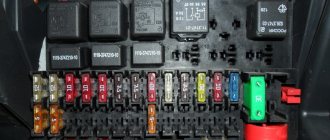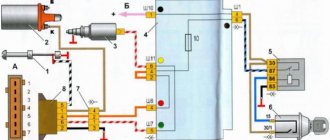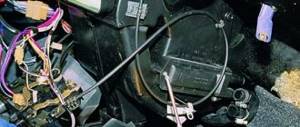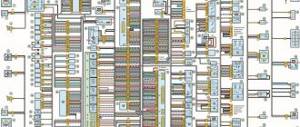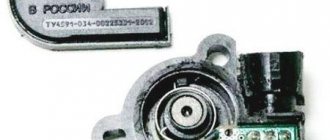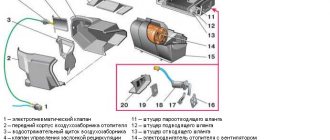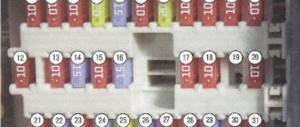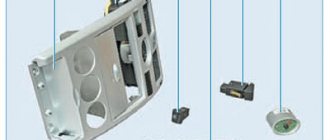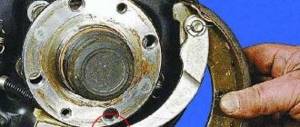#1 akrsandr
- Garage workers
- 732 messages
Good afternoon everyone.
The VAZ 2110-2112 heater control unit is covered (without Automatic fan speed control). Number 2111-8128020.
The fan speeds switch normally, but there is no heat. There is no reaction to turning the temperature selection knob - cold air blows in all modes. ZR wrote that it cannot be repaired, and it is better to buy a new one. But still. Has anyone encountered the exact same problem and solved it? What should be changed (the circuit on the board is not that complicated at first glance)?
High-quality operation of a car’s heater in winter is one of the main conditions for comfortable driving. In domestic vehicles, even in new models, the heater is one of the problematic elements that very often fails. And if in the summer you can turn a blind eye to this, then in cold weather you immediately have to take measures to eliminate the problem.
To eliminate the malfunction, it is first important to diagnose which element of the car’s heating system has failed and repair the non-functioning unit. The easiest way is to turn to specialists for help, but their services are not very cheap. Very often, vehicle owners troubleshoot and repair the heater on their own, since domestic cars are highly maintainable.
This article will talk about how to diagnose a malfunction of the VAZ-2110 heater control unit and repair it yourself.
Design features of the VAZ-2110 stove control unit
One of the common heating system problems that VAZ-2110 owners encounter is the failure or malfunction of the heater control unit. Dozens of them are equipped from the factory with stoves, which are coordinated through an automatic heater control system. In short, the system is called the SAUO block. The main indicators of its malfunction are the operation of the heating system not in all modes. If one or more stove speeds do not work, then most often the problem is in the ACS unit. Thanks to the electronic module of the VAZ-2110, the temperature set by the driver is maintained in the car interior.
Before you begin repairing the VAZ-2110 heater, you need to find out what kind of heater is on your vehicle. Cars that were produced before September 2003 are equipped with old-style stoves. Accordingly, there are significant differences in the design, which are important to pay attention to during repairs.
The ACS unit consists of electronic elements, which are coordinated using handles on the central console of the machine.
The VAZ-2110 stove control unit is equipped with a controller with two handles. The right handle is responsible for turning on a certain fan speed. An additional resistor is directly responsible for switching its speeds. Old style stoves have resistors for two or three fan speeds. The new model stoves have a modified resistor RDO 2123–2118022. The unit for coordinating the operation of the improved stove model has four speeds and does not have an auto mode.
We study the structure and diagram of the VAZ 2110 stove
If you decide to repair your car yourself, you need to have a good knowledge of its components and be able to read drawings. Of course, such skills come with experience in operating and maintaining the VAZ 2110. This time we will study the operation of the heater in detail. If the heating system functions properly, then both the driver and his companions will be comfortable inside the “ten”. This material contains stove diagrams and descriptions for them. The instruction manual also contains this information, but we try to describe complex processes in simple language. Our task is to convey important information to beginners and experienced motorists.
This is what the disassembled heating system of a VAZ 2110 car looks like
Diagnostics of serviceability and dismantling of the stove control unit
The SAUO module is located on the center console of the car and is responsible for proper heating of the interior. Repairing the VAZ-2110 stove control unit requires certain knowledge in electronics, so before you begin repairing the part, you need to determine whether the problem is really in the electronic module itself.
To do this, you must initially dismantle the unit and install a known-good part in its place. Take the SAUO unit from friends or at a service center to diagnose the heating system of your car.
Before performing any work on the vehicle that involves electronics or wiring, turn off power to the battery to avoid shorting or burning out the electronic components.
Then you can proceed directly to removing the unit through which the functionality of the stove is coordinated. To do this, the buttons that are located on the sides of the stove are initially dismantled. The heater controls must be switched to zero positions. Only then can the module be pulled out. This must be done very carefully, since the power plugs are connected to the back of the unit. As soon as you see them, they must be carefully disconnected so as not to damage the contacts. At this point, dismantling can be considered complete.
The working unit is installed on the standard seat, and the operation of the vehicle’s heating system is checked. If the stove functions correctly with the new unit, then the fault is in the ACS unit itself. Otherwise, it is necessary to diagnose other elements of the heating system.
DIY repair of the VAZ-2110 heater control unit
If during diagnostics it turns out that the problem is in the heater control module, then you need to try to repair it or install a new part. Since the price of new electronic units is quite high, the right decision would be to repair the control part, especially since this requires only basic knowledge of electronics, the ability to use a tester and a soldering iron if necessary.
Before you begin, you need to disassemble the heater control unit. To do this, the front cover with regulators is removed from the latches from the previously dismantled electronic module. Next, a special glass cover is detached. Using a screwdriver, unscrew two screws on the front panel of the unit and one on the rear wall. After this, the top cover of the module can be removed; this must be done very carefully so as not to damage the contacts inside the part.
Inside the module there are electronic tracks, contacts and resistors that are responsible for the high-quality functioning of the vehicle’s heating system controllers. It is necessary to inspect all contacts, electronic tracks on the board, resistors and jumpers. High operating temperatures can cause the board to become very hot, which will lead to disconnection of the contacts. Particular attention should be paid to the power supply points and the contacts should be cleaned. If there is visible damage to the electronic circuit, it is necessary to solder the damaged elements. In parallel, using a tester and an ohmmeter, the functionality of the electronic elements and resistors located on the board is checked. If necessary, non-functioning parts on the ACS module board are replaced.
After troubleshooting, the heater control unit is assembled in the reverse order and installed in its original place. Next, you need to connect the battery power and check the operation of the vehicle’s heating system; if necessary, adjust the heater controller.
Main problems with the VAZ 2110 heater
Problems that can affect the operation of a car are very diverse. We will give examples of the most common ones that you can fix yourself.
Amount of fluid in the system
Most often, interruptions in the operation of the heater occur when there is insufficient amount of fluid in the system. You can check its volume visually. To do this, you need to find the expansion tank, located on the left side of the passenger compartment, when looking in the direction of travel, and compare it with the upper mark that the antifreeze should reach when the engine is “cold”. If the volume of liquid is insufficient, then the reason may be a simple underfill, or perhaps depressurization of the system.
If you suspect that the system has leaked, you need to check: how well the clamps are tightened; are there any cracks or abrasions on the pipes; whether the fittings are damaged.
The reason for the lack of antifreeze in the heating system can also be leaking radiators, which can be easily determined visually. To eliminate the leakage, you will need to replace the clamps, pipes, and also solder the fittings. If you want to avoid additional repairs for a long time, then it is also better to replace the fittings. You can see more detailed information about repairing the VAZ 2110 stove in the video.
Damper malfunction
The car heater is equipped with two dampers - upper and lower. The upper one is responsible for the flow of cold air, the lower one controls the flow of heated air into the cabin. Sometimes it happens that the driver hears the damper moving, and the heater radiator is hot, but only cold air enters the cabin. This indicates a breakdown of the damper itself or its drive.
If the ACS controller set point is set to the minimum position and cold air blows, but when switching to the maximum position nothing blows at all, then it makes sense to talk about interruptions in the operation of the internal damper.
Repair of the VAZ 2110 heater damper begins with dismantling the heater itself. First you need to remove the frill, wipers, all engine compartment trims, vacuum hose, and strut extensions. The liquid can be drained, but home “Kulibins” recommend cutting out the chops and, when removing the radiator hoses, quickly inserting them, which will lead to the loss of half a liter of liquid, but will save time. In order for the stove to easily leave its usual place, you will have to, in addition to dismantling the heater mount, remove the throttle valve along with the corrugation coming from the air filter, its mounting studs and, as a bonus, the windshield wiper trapezoid. After this, you need to remove the rear heater casing and pull out the radiator. Next comes replacing the damper. The new damper must be installed so that the fork, which is located on the damper axis, engages with the lever. It must be in the raised position at the time of installation. Next, the heater is reassembled in the reverse order, liquid is poured into the system. After assembling the stove, do not forget to check the tightness of all joints. Step-by-step instructions for repairing the VAZ 2110 heater damper can be obtained by watching the video.
Fan problems
In winter, the heater fan has to be turned on quite often. The most common problem that distracts and irritates the driver while driving is its noise, and sometimes even a heart-rending squeal. After which the repair of the VAZ 2110 stove fan begins.
Before you begin repairing the fan, it is necessary to establish the reason for this incorrect behavior. Unpleasant sounds may appear due to the fact that the lower part of the heater housing, which is attached with hooks, has become unfastened. This problem can be solved by simply returning the hooks to their place. Another common cause of noise is broken tabs on the heater housing. Only a new building can cure such a disease.
The fan can also scream heart-rendingly due to uneven shaft expansion coefficients. Extraneous noise appears at a sufficiently low temperature or high level of wear. In such a situation, either the entire motor or its bushings are replaced, which after replacement must be treated with a rubber.
In some cases, the source of squealing may be textolite washers that eliminate axial play. They are located on both sides of the motor shaft. This problem can be solved in the following way: we begin to repair the VAZ 2110 stove fan by dismantling it. After this, the unit must be carefully inspected for damage and carefully cleaned. You can rid it of axial play using a fluoroplastic washer or something similar. The materials should be subject to minimal friction between each other, for which they need to be coated with a thick lubricant. MC1000 is perfect. Next, the fan is disassembled, washers are made, lubricated and installed in its original place. The assembly is assembled in the reverse order. You can get more detailed information about repairing the VAZ 2110 stove fan by watching the video.
Adjusting the stove controller
The manufacturing plant provides for heating the interior to the specified temperature in fifteen minutes with a deviation of up to two degrees. Use the controller knob to set a comfortable temperature in the car interior.
To check the proper functioning of the stove, use a regular mercury room thermometer. If after fifteen minutes the interior has not warmed up to the required temperature, the controller must be adjusted.
To do this, pull the heater control module back out and rotate the temperature regulator, first to the maximum value, then in the opposite direction. After carrying out such actions, install the unit in place and check the operation of the stove again.
At the same time, it is necessary to check the operation of the heater dampers. If there are extraneous sounds when switching temperature modes, then you need to check the condition of the dampers. If cold air flows well, but hot air hardly flows in, then the lower damper is faulty. If there is no normal flow of cold air but there is a good flow of hot air, there is a problem with the upper damper. The reason may be deformation of the dampers under the influence of air of different temperatures. In this case, it is better to replace the standard plastic dampers with aluminum analogues, which are more resistant to temperature changes.
Let's sum it up
Malfunctions of the VAZ-2110 heater control unit can lead to both incorrect functioning of the vehicle’s heating system and complete failure of the heater. During the cold season, this will affect not only a comfortable stay in the car, but also safe driving for the driver of the vehicle.
Repairing the stove control unit can be done on your own if you have basic knowledge of electronics, a desire to work and improve your comfort.
High-quality repairs and timely regular inspections of the unit before the onset of cold weather will help you save money on stove repair services at service centers and the purchase of expensive heating system elements.
VAZ 2110 often have problems with the stove, this is their disease. All this happens due to improper operation of the SAUO unit. Before you begin repairs, you need to understand why the breakdown occurred. To do this, we connect a known-good unit. If the heater functions properly with the ACS operating unit, then the problem is related to it. We dismantle the buttons next to the heater unit, after which we set the regulators to the zero position and remove the front cover and glass.
We remove the board from the plastic case and check the integrity of all tracks, jumpers and resistors. in a particular case, the first speed of the heater did not work because the jumper was broken. We solder it on one side and the other. Assembly occurs in reverse order. All fan speeds, except the last one, are connected through an additional heater resistor, which is located under the frill. One of the possible reasons why the first heater speed does not work is a faulty resistor. Depending on the ACS unit, this additional resistor is divided into types. The first resistor RDO 2108-8101081 is used in the oldest SAUO units, which had only two speeds.
RDO 2110-8118022-01 is installed on a modified heater; this unit has three speeds. The most common cause of breakdown is that all stove speeds stop functioning except the maximum one. This happens due to the thermal fuse being disconnected. You just need to solder it in place. But if it continues to disconnect, then you need to inspect the motor, it’s probably taking too much current. RDO 2123-2118022 is the latest version, has 4 speeds and no automatic mode.
Stove design
This unit includes several devices. The radiator is the main element of the stove - it heats the air entering the cabin. It is located under the hood. The next component is the air distributor, equipped with special pipes that run through the cabin of the 2110.
Removing a faulty radiator, you can get to it through the hood
If we compare the “ten” with previous models, an important innovation has appeared in its heating system - an evaporator (the diagram includes it in the list). The device is installed in an air conditioning system. Not all owners know about its existence, since it rarely fails.
To control the operation of the heater, an SUAO unit is installed in the VAZ 2110 car, which is called a controller in the technical operating manual. The unit works in conjunction with a temperature sensor in the cabin; it is also called a ceiling sensor. The sensor reports the temperature to the unit, then this indicator is compared with the set temperature on the handle. If the indicators differ by more than 2°, warm or cooled air is supplied to the VAZ 2110 interior.
It’s worth taking a closer look at the handle, or more precisely at its extreme positions – MAX and MIN. If the heater knob is set to one of these indicators, heat is supplied without the operation of the temperature sensor in the cabin. The scheme includes all of the above elements.
The device of the “tens” heater includes another unit - a gearmotor, which is responsible for opening and closing the damper. The miniature electric motor performs an important task in the operation of the heating system, as evidenced by the diagram. If the gearmotor is faulty, the system will only produce cold or hot air. If the gearmotor fails when the damper is closed, the system will stop functioning. We have described the main components of the VAZ 2110 heater; the diagram contains a more detailed list.
Let us highlight the main components of the system:
- Radiator.
- Air distributor.
- SUAO block.
- Ceiling sensor.
- Lever.
- Damper.
- Gearmotor.
Radiator
In the heating system, a radiator is installed for heating, which enters the VAZ 2110. It is also called a heat exchanger. Heating is carried out by the heat of the antifreeze. This component is connected to the engine cooling system by pipes and hoses. Antifreeze constantly circulates through the heat exchanger of the stove. The damper, based on the commands of the unit, directs the incoming air to the radiator or directly into the passenger compartment. If the heater damper is in an intermediate position, then one part passes through the heat exchanger, and the second bypasses the radiator. If we compare this part of the stove with previous generations of the VAZ, it has a number of useful improvements, as the diagram demonstrates.
SUAO and ceiling sensor
The process of removing the interior temperature sensor
These components of the VAZ 2110 heater are connected and work according to the following principle:
- The sensor determines the temperature inside the car;
- This data is sent to the SUAO block;
- The block compares the temperature with the position set on the handle of the VAZ 2110 stove;
- After comparison, the position of the damper changes or remains the same - it depends on the indicator;
- This way the temperature in the cabin is controlled;
- If the heater handle is set to MAX or MIN, then the data from the ceiling sensor is not taken into account.
All these actions are demonstrated by the diagram. The block is a set of microcircuits; the normal operation of the stove depends on its serviceability. Both the sensor and the control system can be replaced.
Damper and gearmotor
The heater gear motor changes the position of the damper, due to which air is supplied to the cabin. This component is controlled by the control system block. If the device is faulty, the damper will not move. The unit is a miniature electric motor. When it breaks, it is usually replaced, since repairing it will be problematic. This also applies to the damper. The diagram shows the connections between the gearbox and the block.

